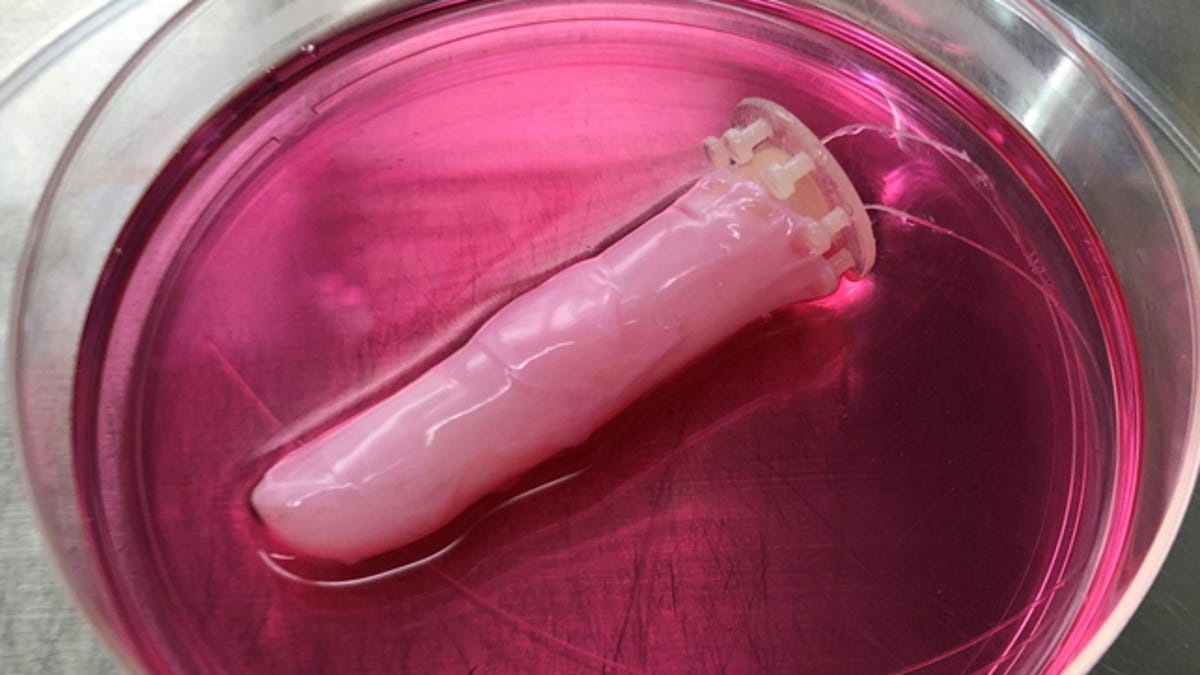Scientists Craft 'Living Skin' for Robots, Made of Human Cells

In this culture medium, a robotic finger covered with living human skin self-heals after researchers covered its wound with a collagen sheet.
What's happening
Japanese researchers covered a robot finger with a self-healing pliable sheet made of human skin cells.
Why it matters
Helping robots resemble humans could improve their integration with our society. We'd like them more, trust them more and communicate with them better.
What's next
The team will focus on refining their prototype to make it more sophisticated and translatable to real-world robotics.
If scientists are ever to deploy realistic humanoid robots to roam our society, they'll need to create an artificial version of every single human trait. Then they'll have to put it all together. A daunting endeavor. But we can simplify the task by grouping things into two main categories.
First up, there's the mental facet. Things like consciousness, autonomy, imagination and perhaps even body reflexes. Second, there's the physical stuff. Fluid movement, eye control, casual gait and, importantly, skin.
Our sweaty, supple human skin is absolutely integral to our lifelike veneer.
And on Thursday, in the journal Matter, Japanese scientists announced they've made some headway in this regard. They presented a robotic finger that's coated with "living skin," aka a prototype of skin made out of actual, living, human cells.
The team's new robot finger covered with 'living skin.'
"I think living skin is the ultimate solution to give robots the look and touch of living creatures since it is exactly the same material that covers animal bodies," Shoji Takeuchi, a professor at the University of Tokyo, said in a statement.
Not only does this material resemble and feel like human skin, but the new study's team says that because it's made of real skin cells, it also can self-heal and is water repellant. Attached to a robot, this sort of skin sheet can therefore repair its own cuts and scrapes, like normal human skin can.
However, though Takeuchi said the team is "surprised by how well the skin tissue conforms to the robot's surface," the researcher adds the caveat that "this work is just the first step toward creating robots covered with living skin."
The newly developed robot skin still isn't quite as strong as natural skin and needs external help sustaining itself. Further down the line, the research team also intends to add hair follicles, nails and formal sweat glands to make the sheet more lifelike.
Nonetheless, Takeuchi remains focused on the main motivation to construct such humanlike robot skin. It's that the silicone skin presently employed while building artificial beings just can't mimic human appearance. Yet, to improve likability and kinship with bots, we need to get them as close to human as possible.
It's a conundrum that requires breaking out of the norm and innovating in a different direction.
An image showing the robot finger with and without skin.
Silicone skin, for instance, can't create delicate nuances like flexible pores or wrinkles that come with age. It has a ceiling on how closely it can replicate the human organ. And Takeuchi also said other attempts to create human skin have had limited success because they require skilled artisans to cut and tailor sheets of lab-grown skin to fit them on a robot finger.
"To efficiently cover surfaces with skin cells, we established a tissue molding method to directly mold skin tissue around the robot, which resulted in a seamless skin coverage on a robotic finger," Takeuchi said.
How to build humanoid robot skin
Basically, the team took a standard robotic finger, then submerged it in a cylinder filled with a special solution that fostered the right conditions to grow living skin.
This solution was filled with collagen, a protein that helps with skin elasticity and stretchiness, as well as what are called "human dermal fibroblasts." These fibroblasts just refer to the skin cells that the researchers used. Together, the two components comprise traditional skin tissue -- it's the same kind of duo found with our own bodies.
Next, the collagen and fibroblast mixture shrank around the robotic finger, tautly covering it like a skin primer of sorts. This was the first layer of skin.
The second layer, by contrast, swapped the fibroblasts for a new type of cell line called human epidermal keratinocytes -- that's because these cells make up about 90% of the outermost layer of skin in our bodies. Finally, once the keratinocytes stuck to the fibroblast primer, the mechanism was pretty much complete. The robot finger had skin.
A diagram showing the process of growing the robot's new living skin.
"The finger looks slightly 'sweaty' straight out of the culture medium," Takeuchi said, adding that "since the finger is driven by an electric motor, it is also interesting to hear the clicking sounds of the motor in harmony with a finger that looks just like a real one."
And though the team's prototype is still in its early stages -- allowing it to sustain itself without any external help is a crucial hurdle yet to be crossed -- it could be a promising step forward for next-gen robotics. In fact, the team even suggests their living skin concept might one day dip into the mental facet of humanoid robotic construction: adding sensory neurons.
Or, in other words, they think there might be a way to hardwire it to a future robot brain. Making a humanlike robot brain, however, is arguably the greatest challenge of all.

